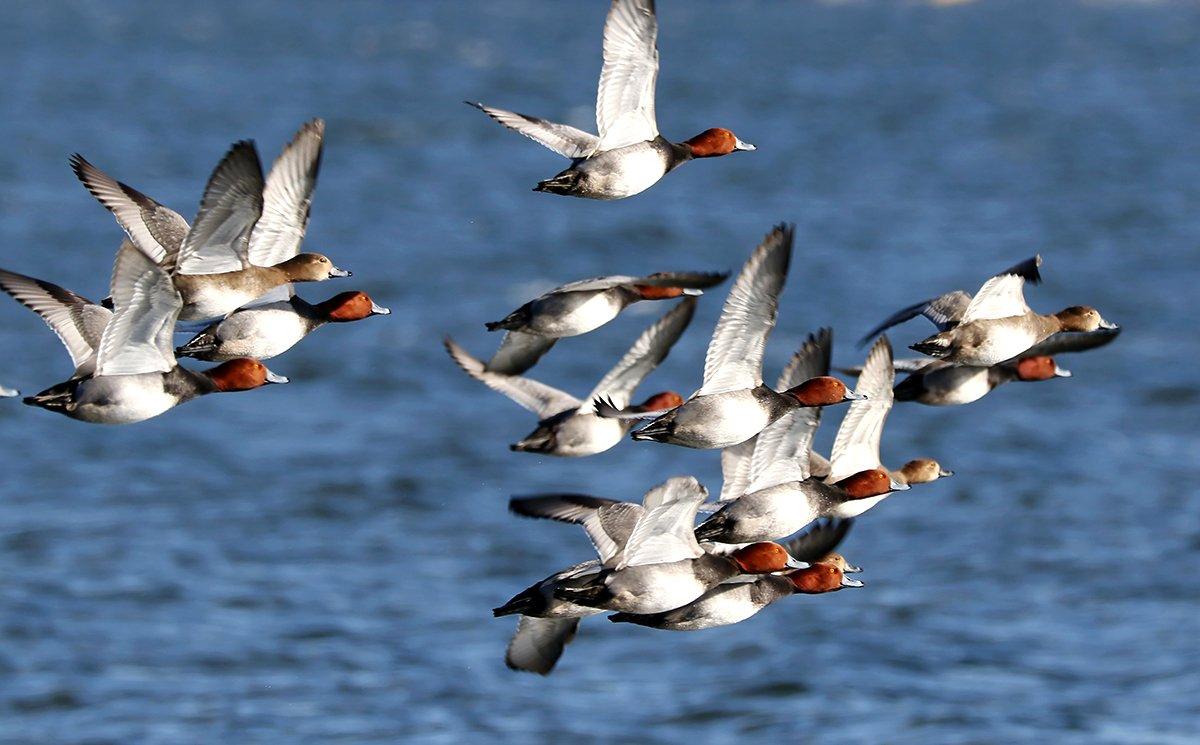Birds on the move, but low water continues to plague many regions
Redheads have arrived along the Texas coast, but many marshes have become salty because of low water. Photo by Jim Nelson
For many waterfowlers in the Central Flyway, especially in the upper states, the season was almost finished before it began. Low duck numbers and drought conditions at the start of the season were quickly followed by cold temperatures and freeze-up on the few wetlands that had water. Hunters who didn’t get out early and hunt hard likely missed what turned out to be a brief window of opportunity.
“Yeah, we’ve been done for a long time,” said Mike Szymanski of the North Dakota Game and Fish Department, when I inquired about the status of the season. “North Dakota had 15 to 24 inches of snow on November 10, followed by temps that have been well below freezing for almost the whole time since. Everything left pothole country by November 12. We had strong numbers of migrant geese and ducks for about five days this year.”
Paul Johnson of Lynn Lake Lodge (lynnlakelodge.com) in South Dakota had a similar report.
“Our last hunters finished up here November 15,” he said. “The lakes are almost all frozen up now, with just a few strips of open water. Ice fishing started around November 20. The Friday after Thanksgiving, we saw a few ducks and snow geese feeding in the area, but nothing since then. We are basically calling the season ended.”
Johnson said he considered this an average season at best — probably a little below average because of the dry conditions and spotty migration. If you blinked and didn’t hunt early in the Dakotas, you likely missed the season.
Farther south in my home state of Nebraska it was more of the same.
“At this point, most of our shallow wetlands are frozen over,” said John McKinney of the Nebraska Game and Parks Commission. “We had a few favorable fronts and good pushes of birds around Veterans Day weekend, but overall, due to a lack of water across the landscape, birds kept flying. Since the last update [in November], there has been no change in water levels or precipitation.”
However, there is some hope for goose hunters.
“Canada geese can be found throughout the state, and snow geese are beginning to migrate through, as well,” McKinney said. “If appropriate habitat can be found, along with desired weather conditions, goose hunting might prove to be more favorable than duck hunting this year. However, the challenge for hunters will continue to be finding water.”
A fellow Nebraska duck hunter confirmed McKinney’s observations, saying his duck season was tough. Granted, a tough season for my friend, who is accustomed to shooting a lot of ducks each year, would probably be considered a good season by many of us. However, when we spoke earlier in December, he’d been done duck hunting for a while and was getting his goose blind ready for the late season.
At this point, it’s probably a good idea for other Cornhusker waterfowlers to do the same. Nebraska’s dark goose season runs into early February, and the snow goose season extends into spring.
Again, water, or the lack thereof, will be the critical factor in determining how successful the goose season is as we move into late winter. The same holds true for Kansas hunters.
“Not much has changed since the mid-season report,” said Tom Bidrowski of Kansas Department of Wildlife and Parks. “Conditions are the same, and to some extent, we have the same birds. Most of Kansas remains in drought, which greatly impacted duck hunting in many areas.”
It’s not all bad news, though.
“Southeastern Kansas is the bright spot,” Bidrowski said. “Hunters there had favorable reports of early and mid-season success.
“If the weather doesn’t get too severe, we should have a good late season. However, hunters should expect wary birds, as they’ve been here since November and have been under heavy hunting pressure. Reservoir and river hunters are enjoying some success but have to work a bit more than usual for their birds.”
Bidrowski summed up the Sunflower State’s boom-or-bust season like this: “As expected, with reduced water levels displacing birds and hunters, 2022 has not been a typical year. For some hunters, there was no duck season, and for many, it was a not-so-good season. But those who found water are having a great season.”
Oklahoma might be the place to be this season for Central Flyway 'fowlers. Guide Cole Rogers (Sandstone Outfitters on Facebook) had a more optimistic report.
“We’re definitely holding a lot of little geese as of early December,” Rogers said. “There are still quite a few cranes sticking around, as well. However, ducks are still low, since there is not a ton of small water. We’ve also been pretty warm, but it’s looking like a cool-down is coming, so hopefully that brings more ducks.”
Farther south, at the bottom of the flyway, it’s been a mix of all of the above.
“It’s difficult to rubber-stamp a state this big,” said Kevin Kraai, of the Texas Parks and Wildlife Department. “For the most part, though, we started the season very dry across much of the state.”
Kraai said the coast had some water and had received a few inches of rain this fall. However, many of the marshes have turned very salty because of low water. The High Plains, Panhandle, and East Texas regions also don’t have much fresh water because of the drought, although Kraai pointed out that several reservoirs in eastern Texas rose a couple of feet with recent rains. That translates to a significant increase in the amount of surface water, especially during a year such as this.
“Overall, there is not an abundance of ducks across much of the state, and there likely won’t be as the season progresses,” Kraai said. “However, for those hunters who have the capability to pump water, it’s been a fairly good duck season. There is an abundance of cackling geese, but most of them are found in urban areas, roosting inside city limits, where they’re safe, and then flying out to feed. Cranes are still doing their thing wherever they can find water.”
That’s been the critical issue this fall up and down the flyway — finding water.
“It’s certainly been feast or famine,” Kraai said.
And although he was referring to Texas, that statement pretty much sums up the entire season for Central Flyway waterfowlers.
(Don't miss: Game-Changers: How Ducks React to Shifting Conditions)














